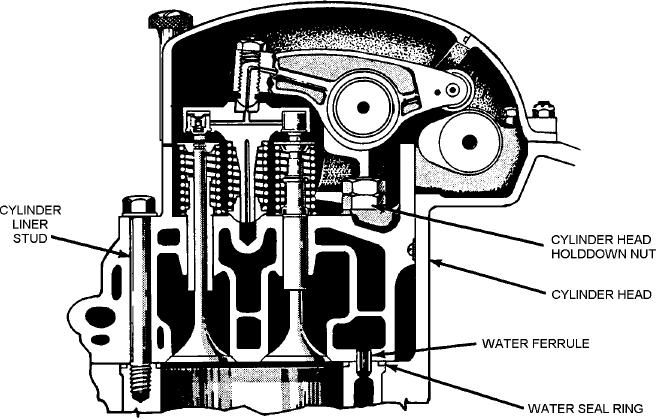
The oil pump in the lubricating system draws oil
The I-head (overhead-valve) type of cylinder head
from the oil pan and sends it to working parts in the
(fig. 3-22) contains not only water jackets for cooling
engine. As the oil drains off and runs down into the pan,
spark-plug openings, valve pockets, and part of the
it is picked up by the oil pump again and recirculated
combustion chamber, but it also contains and supports
through the engine.
the valves and valve operating mechanisms. In this type
of cylinder head, the water jackets must be large
The crankcase also has mounting brackets that
enough to cool not only the top of the combustion
support the entire engine on the vehicle frame. These
chamber but also the valve seats, valves, and
brackets are either an integral part of the crankcase or
valve-operating mechanisms.
are bolted to it in such a way that they support the
engine at three or four points. These points of contact
Crankcase
usually are cushioned by rubber mounts that insulate
the frame and body of the vehicle from engine
The crankcase is that part of the engine block below
vibration, and therefore, prevent damage to the engine
the cylinders. It supports and encloses the crankshaft
supports and the transmission.
and provides a reservoir for the lubricating oil.
Sometimes there are places provided on the crankcase
As a result of normal engine operation, water or
for the mounting of the oil pump, oil filter, starting
gasoline may seep down and appear in the crankcase.
motor, and the generator or alternator. The lower part of
These liquids evaporate after the engine reaches
the crankcase is the oil pan, which is bolted at the
operating temperature, and the vapors are removed by
bottom. The oil pan may be made of pressed steel or
ventilation.
cast metal and holds the lubricating oil for the engine.
Exhaust Manifold
Since it is the lowest part of the power plant, the oil pan
must be strong enough to withstand blows from flying
The exhaust manifold is essentially a tube that
stones and obstructions sticking up from the road
carriers waste products of combustion from the
surfaces. Checking for dents in the pan and oil leaks is
cylinders. On L-head engines, the exhaust manifold is
an important part of your job. Get into the habit of
bolted to the side of the engine block; on
checking the spot where the vehicle was parked for
overhead-valve engines, it is bolted to the side of the
water or oil leakage.
ASf03022
Figure 3-22.--Cylinder head for overhead valve engine.
3-19

